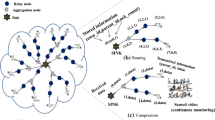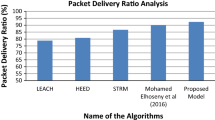Abstract
The past few years have witnessed increased interest in the potential use of wireless sensor networks (WSNs) in applications such as battlefield assistance, adversary intrusion detection, distributed signal processing, etc. In these applications, multimedia semantic information and video content are extremely sensitive to malicious attacks, including eavesdropping/intercepting of ongoing traffic, and manipulating/counterfeiting of the existing media flows. From a security standpoint, it is very important to transmit authentic and accurate data to surrounding sensor nodes and to the sink. However, securing sensor networks poses unique challenges because these tiny wireless devices are deployed in large numbers, usually in unattended environments, and are severely limited in their capabilities and resources like power, computational capacity, and memory. In this work, a secure and selective encryption framework is proposed so as to optimize network lifetime and video distortion for an energy constrained wireless video sensor network (WVSN).











Similar content being viewed by others
References
Ahn, J., Shim, H. J., Jeon, B., & Choi, I. (2004). Digital video scrambling method using intra prediction mode. In Proceedings of Springer ’04.
Akyildiz, I. (2007). A survey on wireless multimedia sensor networks. Computer Networks, 51, 921–960.
Akyildiz, I., Sankarasubramaniam, Y., Su, W., & Cayirci, E. (2002). Wireless sensor networks. A survey. Computer Networks, 38, 393–422.
Elbiri (2009). Stochastic distributed energy-efficient clustering (SDEEC) for heterogeneous wireless sensor networks. In ICGST-CNIR 9.
Fowdur, T. P., & Soyjaudah, M. S. (2010). Highly scalable JPEG image transmission with unequal error protection and optimal feedback. Telecommunication Systems, 49, 355–377.
Guihai, C. (2009). AEETC—adaptive energy-efficient timing control in wireless networks with network coding. Telecommunication Systems, 45, 289–301.
Heinzelman, W., Chandrakasan, A., & Balakrishnan, H. (2000). Energy-efficient communication protocol for wireless sensor networks. In Proceeding of the Hawaii international conference system sciences.
Heinzelman, W., Chandrakasan, A., & Balakrishnan, H. (2002). An application specific protocol architecture for wireless microsensor networks. IEEE Transactions on Wireless Communications, 4, 660–670.
He, Z., & Wu, D. (2006). Resource allocation and performance analysis of wireless video sensors. IEEE Transactions on Circuits and Systems for Video Technology, 16, 590–599.
Joskowicz, J., & Carlos Lopez, A. (2012). A parametric model for perceptual video quality estimation. Telecommunication Systems, 49, 49–62.
Maniezzo, D., Yao, K., & Mazzini, G. (2002). Energetic trade-off between communication and computation resource in multimedia surveillance sensor network. In Proceedings international workshop on mobile and wireless communications network.
Mishra, S., Reisslein, M., & Xue, G. (2008). A survey of multimedia streaming in wireless sensor networks. IEEE Transactions on Communications Surveys and Tutorials.
Pahalawatta, P. (2007). Content-aware resource allocation and packet scheduling for video transmission over wireless networks. IEEE Transactions on Selected Areas of Communication, 25, 749–759.
Qing, L. (2006). Design of a distributed energy efficient clustering algorithm for heterogeneous wireless sensor networks. Computer Communications, 29, 2230–2237.
Sajjanhar, U., & Mitra, P. (2007). Distributive energy efficient adaptive clustering protocol for wireless sensor networks. In Proceedings of international conference on mobile data management.
Shakshuki (2008). Software agent-based directed diffusion in wireless sensor network. Telecommunication Systems, 38, 161–174.
Shiguo, L. (2006). Secure advanced video coding based on selective encryption algorithms. IEEE Transactions on Consumer Electronics, 52.
Shiguo, L., & Chen, X. (2010). Lightweight secure multimedia distribution based on homomorphic operations. Telecommunication Systems, 49, 187–197.
Smaragdakis, G., Matta, I., & Bestavros, A. (2004). A stable election protocol for clustered heterogeneous wireless sensor networks. In Proceedings of second international workshop on sensor and actor network protocols and applications (SANPA ’04).
Stockhammer, T. (2003). H.264/AVC in wireless environments. IEEE Transactions on Circuits and Systems for Video Technology, 13, 657–673.
Tong, X. (2007). Distortion-driven video streaming over multihop wireless networks with path diversity. IEEE Transactions on Mobile Computing, 16, 1343–1356.
Wang, H. (2010). On energy efficient encryption for video streaming in wireless sensor networks. IEEE Transactions on Multimedia, 12, 417–425.
Wiegand, T. (2003). Overview of the H.264/AVC video coding standard. IEEE Transactions on Circuits and Systems for Video Technology, 13, 560–576.
Xin, G. (2009). A new load balancing and data collection algorithm for energy saving in wireless sensor networks. Telecommunication Systems, 45, 313–322.
Author information
Authors and Affiliations
Corresponding author
Rights and permissions
About this article
Cite this article
Varalakshmi, L.M., Sudha, G.F. & Jaikishan, G. A selective encryption and energy efficient clustering scheme for video streaming in wireless sensor networks. Telecommun Syst 56, 357–365 (2014). https://doi.org/10.1007/s11235-013-9849-0
Published:
Issue Date:
DOI: https://doi.org/10.1007/s11235-013-9849-0




